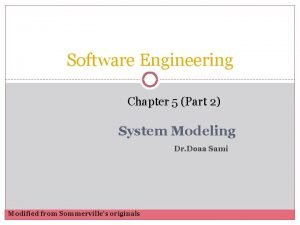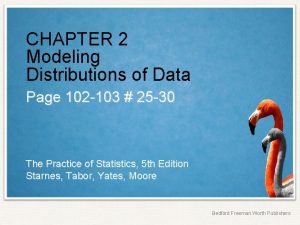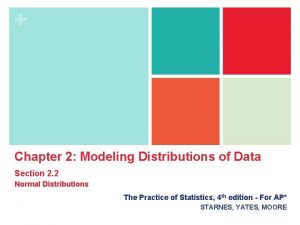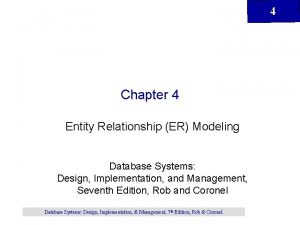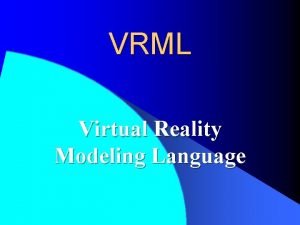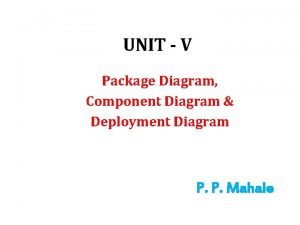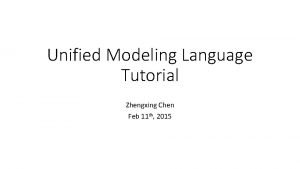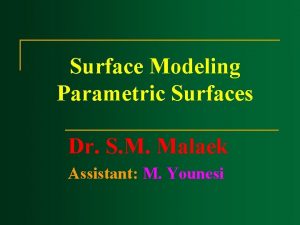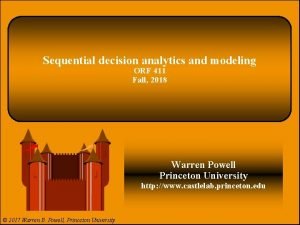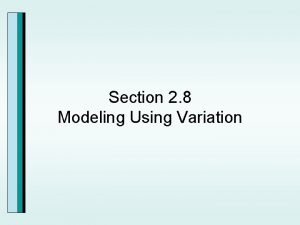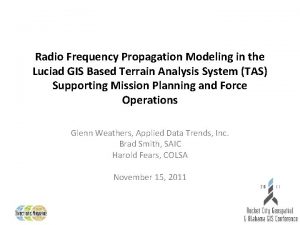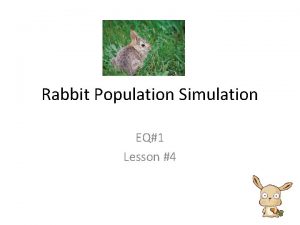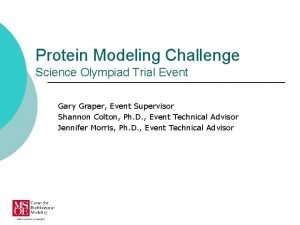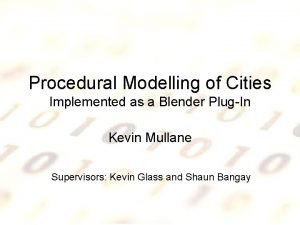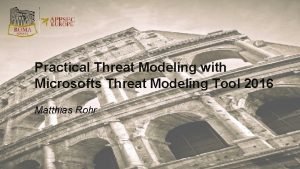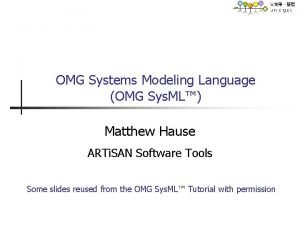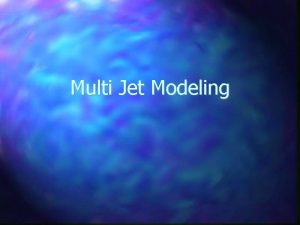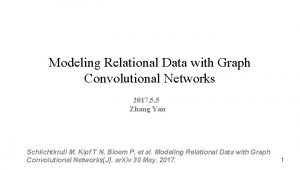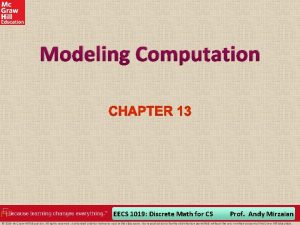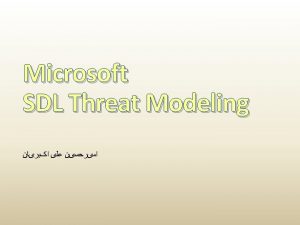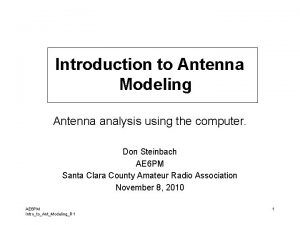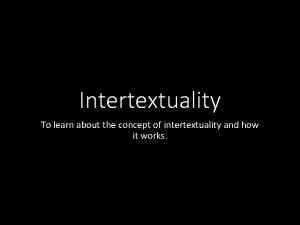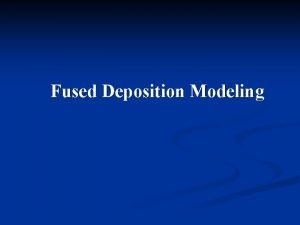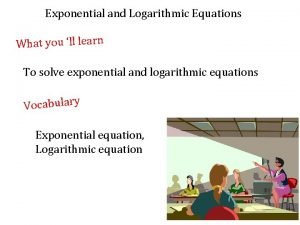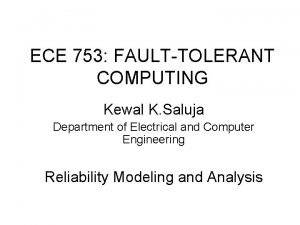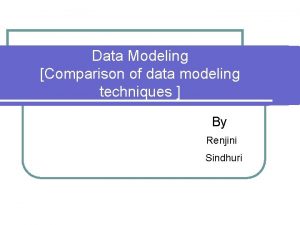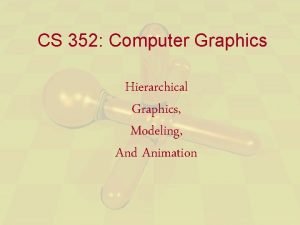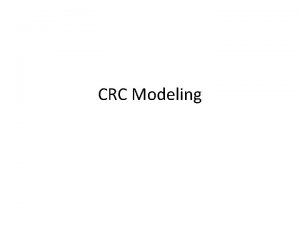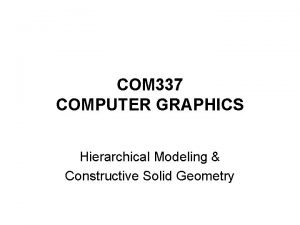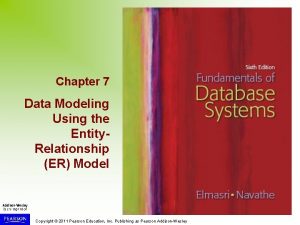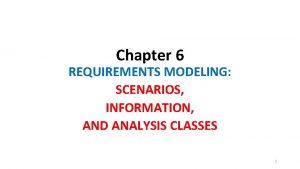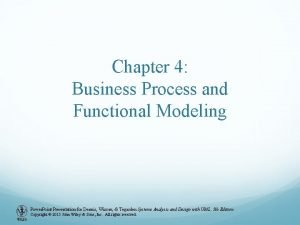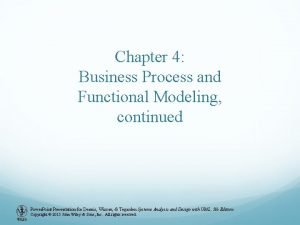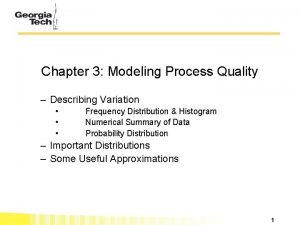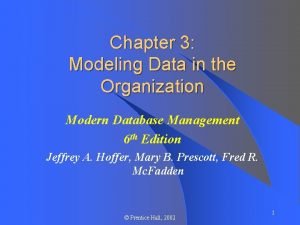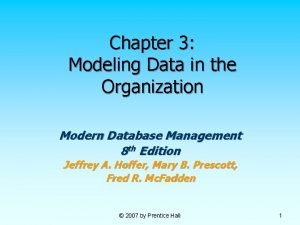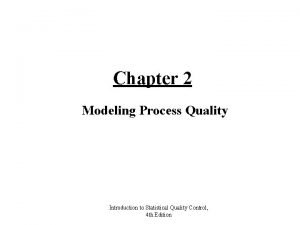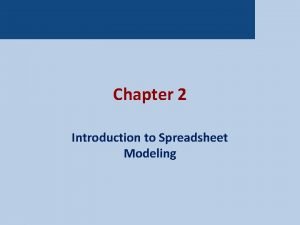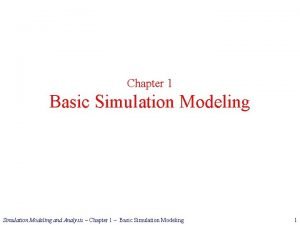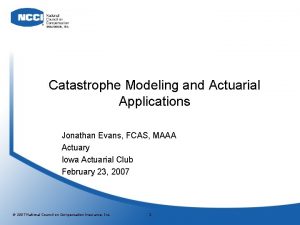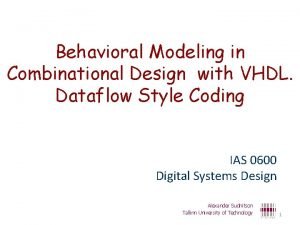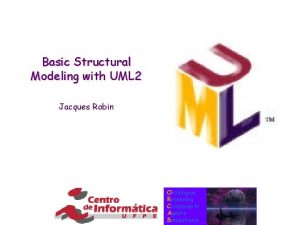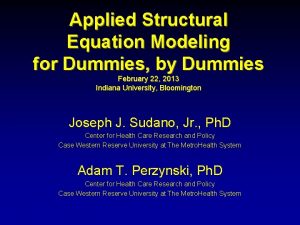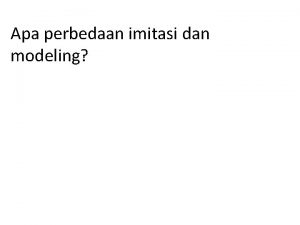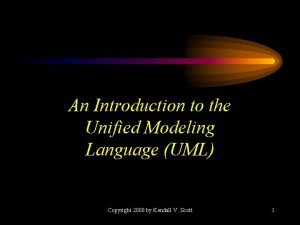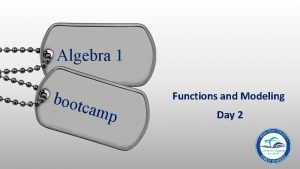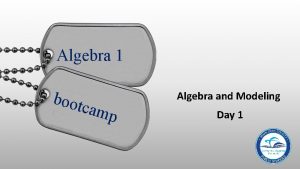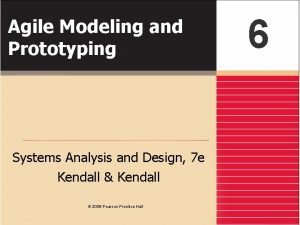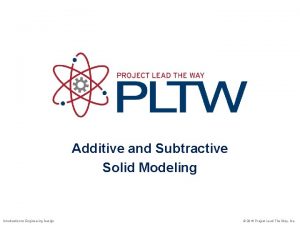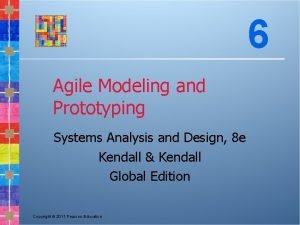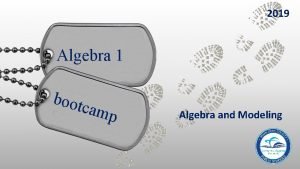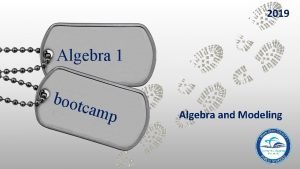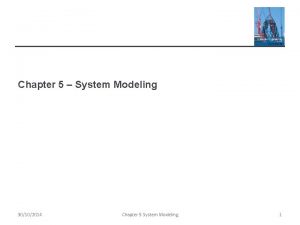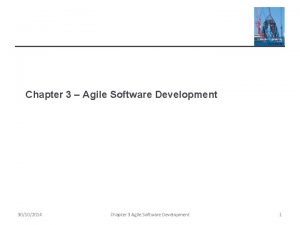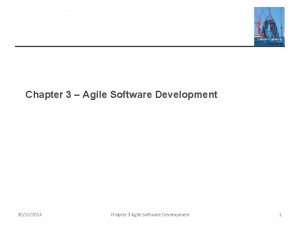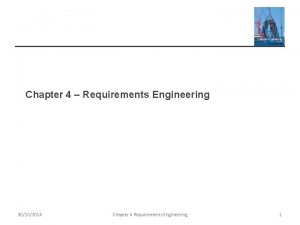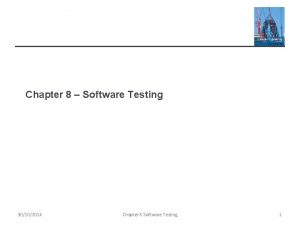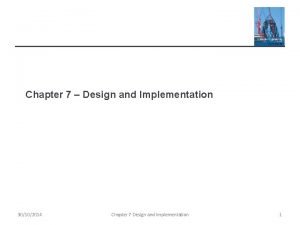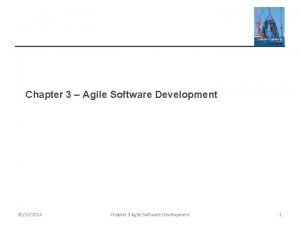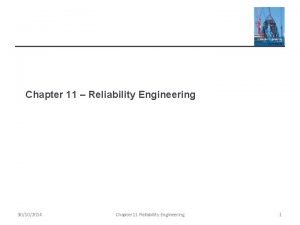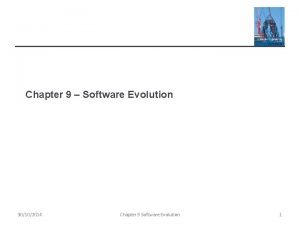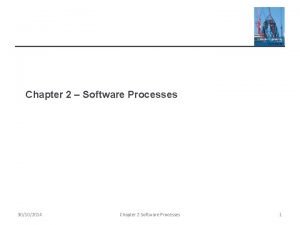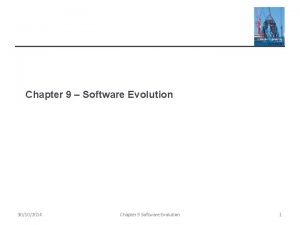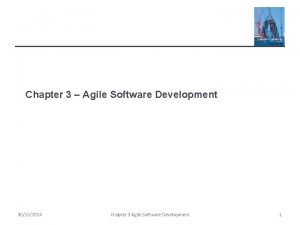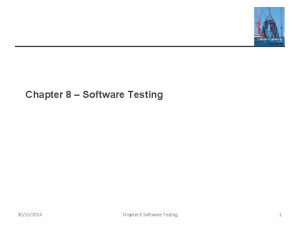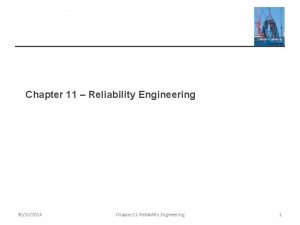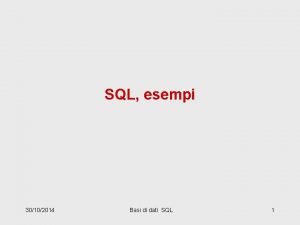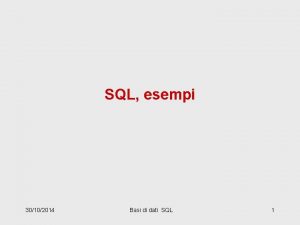Chapter 5 System Modeling 30102014 Chapter 5 System













































































- Slides: 77

Chapter 5 – System Modeling 30/10/2014 Chapter 5 System Modeling 1

Topics covered ² Context models ² Interaction models ² Structural models ² Behavioral models ² Model-driven engineering 30/10/2014 Chapter 5 System Modeling 2

System modeling ² System modeling is the process of developing abstract models of a system, with each model presenting a different view or perspective of that system. ² System modeling has now come to mean representing a system using some kind of graphical notation, which is now almost always based on notations in the Unified Modeling Language (UML). ² System modelling helps the analyst to understand the functionality of the system and models are used to communicate with customers. 30/10/2014 Chapter 5 System Modeling 3

Existing and planned system models ² Models of the existing system are used during requirements engineering. They help clarify what the existing system does and can be used as a basis for discussing its strengths and weaknesses. These then lead to requirements for the new system. ² Models of the new system are used during requirements engineering to help explain the proposed requirements to other system stakeholders. Engineers use these models to discuss design proposals and to document the system for implementation. ² In a model-driven engineering process, it is possible to generate a complete or partial system implementation from the system model. 30/10/2014 Chapter 5 System Modeling 4

System perspectives ² A system model is not a complete representation of system. § It purposely leaves out detail to make it easier to understand. § A model is an abstraction of the system being studied rather than an alternative representation of that system. § A representation of a system should maintain all the information about the entity being represented. An abstraction deliberately simplifies a system design and picks out the most salient characteristics. § The Power. Point slides that accompany this book are an abstraction of the book’s key points. However, if the book were translated from English into Italian, this would be an alternative representation. 30/10/2014 Chapter 5 System Modeling 5

System perspectives ² You may develop different models to represent the system from different perspectives. § An external perspective, where you model the context or environment of the system. § An interaction perspective, where you model the interactions between a system and its environment, or between the components of a system. § A structural perspective, where you model the organization of a system or the structure of the data that is processed by the system. § A behavioral perspective, where you model the dynamic behavior of the system and how it responds to events. 30/10/2014 Chapter 5 System Modeling 6

UML diagram types ² UML has become a standard language for objectoriented modeling. The UML has 13 diagram types,five of which could represent the essentials of a system. § Activity diagrams, which show the activities involved in a process or in data processing. § Use case diagrams, which show the interactions between a system and its environment. § Sequence diagrams, which show interactions between actors and the system and between system components. § Class diagrams, which show the object classes in the system and the associations between these classes. § State diagrams, which show the system reacts to internal and external events. 30/10/2014 Chapter 5 System Modeling 7

Use of graphical models ² There are three ways in which graphical models are commonly used: ² As a means of facilitating discussion about an existing or proposed system § Incomplete and incorrect models are OK as their role is to support discussion. ² As a way of documenting an existing system § Models should be an accurate representation of the system but need not be complete. ² As a detailed system description that can be used to generate a system implementation § Models have to be both correct and complete. 30/10/2014 Chapter 5 System Modeling 8

Context models 30/10/2014 Chapter 5 System Modeling 9

Context models ² Context models are used to illustrate the operational context of a system - they show what lies outside the system boundaries. ² System boundaries are established to define what is inside and what is outside the system. § They show other systems that are used or depend on the system being developed. ² The position of the system boundary has a profound effect on the system requirements. 30/10/2014 Chapter 5 System Modeling 10

System boundaries ² In some cases, the boundary between a system and its environment is relatively clear. § For example, where an automated system is replacing an existing manual or computerized system, the environment of the new system is usually the same as the existing system’s environment. ² In other cases, there is more flexibility, and you decide what constitutes the boundary between the system and its environment during the requirements engineering process. 30/10/2014 Chapter 5 System Modeling 11

System boundaries § For example, say you are developing the specification for the Mentcare patient information system. This system is intended to manage information about patients attending mental health clinics and the treatments that have been prescribed. In developing the specification for this system, you have to decide whether the system should focus exclusively on collecting information about consultations (using other systems to collect personal information about patients) or whether it should also collect personal patient information. The advantage of relying on other systems for patient information is that you avoid duplicating data. The major disadvantage, however, is that using other systems may make it slower to access information, and if these systems are unavailable, then it may be impossible to use the Mentcare system. 30/10/2014 Chapter 5 System Modeling 12

System boundaries ² In some situations, the user base for a system is very diverse, and users have a wide range of different system requirements. You may decide not to define boundaries explicitly but instead to develop a configurable system that can be adapted to the needs of different users. § This was the approach that we adopted in the i. Learn systems, There, users range from very young children who can’t read through to young adults, their teachers, and school administrators. Because these groups need different system boundaries, we specified a configuration system that would allow the boundaries to be specified when the system was deployed. ² Once some decisions on the boundaries of the system have been made, part of the analysis activity is the definition of that context and the dependencies that a system has on its environment. Normally, producing a simple architectural model is the first step in this activity. 30/10/2014 Chapter 5 System Modeling 13

The context of the Mentcare system Ø The figure is a context model that shows the Mentcare system and the other systems in its environment. The Mentcare system is connected to an appointments system and a more general patient record system with which it shares data. The system is also connected to systems for management reporting and hospital admissions, and a statistics system that collects information for research. Finally, it makes use of a prescription system to generate prescriptions for patients’ medication. 30/10/2014 Chapter 5 System Modeling 14

Process perspective ² Context models simply show the other systems in the environment, not how the system being developed is used in that environment. ² Process models reveal how the system being developed is used in broader business processes. ² UML activity diagrams may be used to define business process models. 30/10/2014 Chapter 5 System Modeling 15

Process model of involuntary detention Ø The figure is a UML activity diagram that shows where the Mentcare system is used in an important mental health care process—involuntary detention. 30/10/2014 Chapter 5 System Modeling 16

UML activity diagrams ² UML activity diagrams show the activities in a process and the flow of control from one activity to another. § The start of a process is indicated by a filled circle, the end by a filled circle inside another circle. § Rectangles with round corners represent activities, that is, the specific subprocesses that must be carried out. § You may include objects in activity charts. Figure shows the systems that are used to support different subprocesses within the involuntary detection process. These are separate systems by using the UML stereotype feature where the type of entity in the box between chevrons is shown 30/10/2014 Chapter 5 System Modeling 17

UML activity diagrams ² UML activity diagrams show the activities in a process and the flow of control from one activity to another. § Arrows represent the flow of work from one activity to another. § A solid bar indicates activity coordination. • When the flow from more than one activity leads to a solid bar, then all of these activities must be complete before progress is possible. • When the flow from a solid bar leads to a number of activities, these may be executed in parallel. Therefore, in the above Figure, the activities to inform social care and the patient’s next of kin, as well as to update the detention register, may be concurrent. 30/10/2014 Chapter 5 System Modeling 18

UML activity diagrams ² UML activity diagrams show the activities in a process and the flow of control from one activity to another. § Arrows may be annotated with guards (in square brackets) that specify when that flow is followed. You can see guards showing the flows for patients who are dangerous and not dangerous to society. • Patients who are dangerous to society must be detained in a secure facility. • Patients who are suicidal and are a danger to themselves may be admitted to an appropriate ward in a hospital, where they can be kept under close supervision. 30/10/2014 Chapter 5 System Modeling 19

Interaction models 30/10/2014 Chapter 5 System Modeling 20

Interaction models ² All systems involve interaction of some kind. § Modeling user interaction is important as it helps to identify user requirements. § Modeling system-to-system interaction highlights the communication problems that may arise. § Modeling component interaction helps us understand if a proposed system structure is likely to deliver the required system performance and dependability. 30/10/2014 Chapter 5 System Modeling 21

Interaction models ² Use case diagrams and sequence diagrams may be used for interaction modeling. § Use case modeling, which is mostly used to model interactions between a system and external agents (human users or other systems). § Sequence diagrams, which are used to model interactions between system components, although external agents may also be included. 30/10/2014 Chapter 5 System Modeling 22

Use case modeling ² Use cases were developed originally to support requirements elicitation and now incorporated into the UML. ² Each use case represents a discrete task that involves external interaction with a system. ² Actors in a use case may be people or other systems. § A use case is shown as an ellipse, with the actors involved in the use case represented as stick figures. 30/10/2014 Chapter 5 System Modeling 23

Transfer-data use case ² A use case in the Mentcare system § representing the task of uploading data from the Mentcare system to a more general patient record system. This more general system maintains summary data about a patient rather than data about each consultation, which is recorded in the Mentcare system. 30/10/2014 Chapter 5 System Modeling 24

Transfer-data use case ² A use case in the Mentcare system § there are two actors in this use case—the operator who is transferring the data and the patient record system. The stick figure notation was originally developed to cover human interaction, but it is also used to represent other external systems and hardware. § Formally, use case diagrams should use lines without arrows as arrows in the UML indicate the direction of flow of messages. Obviously, in a use case, messages pass in both directions. However, the arrows in Figure are used informally to indicate that the medical receptionist initiates the transaction and data is transferred to the patient record system. 30/10/2014 Chapter 5 System Modeling 25

Transfer-data use case ² A use case in the Mentcare system § Use case diagrams give a simple overview of an interaction, and you need to add more detail for complete interaction description. § a standard tabular format maybe the most useful. Figure 5. 4 shows a tabular description of the “Transfer data” use case. 30/10/2014 Chapter 5 System Modeling 26

Use cases in the Mentcare system involving the role ‘Medical Receptionist’ Composite use case diagrams show a number of different use cases. Figure 5. 5 shows all of the use cases in the Mentcare system in which the actor “Medical Receptionist” is involved. Each of these should be accompanied by a more detailed description. 30/10/2014 Chapter 5 System Modeling 27

Sequence diagrams ² Sequence diagrams are part of the UML and are used to model the interactions between the actors and the objects within a system. ² A sequence diagram shows the sequence of interactions that take place during a particular use case or use case instance. ² The focus will be on the basics of this diagram type. 30/10/2014 Chapter 5 System Modeling 28

Sequence diagrams ² The objects and actors involved are listed along the top of the diagram, with a dotted line drawn vertically from these. ² Interactions between objects are indicated by annotated arrows. ² The rectangle on the dotted lines indicates the lifeline of the object concerned (i. e. , the time that object instance is involved in the computation). ² The annotations on the arrows indicate the calls to the objects, their parameters, and the return values. ² The notation is used to denote alternatives. A box named alt is used with the conditions indicated in square brackets, with alternative interaction options separated by a dotted line. ² Read the sequence of interactions from top to bottom. 30/10/2014 Chapter 5 System Modeling 29

Sequence diagram for View patient information 30/10/2014 Chapter 5 System Modeling 30

Sequence diagrams ² Read the sequence of interactions from top to bottom. 30/10/2014 Chapter 5 System Modeling 31

Sequence diagrams ² The following figure shows a further example of a sequence diagram from the same system that illustrates two additional features. These are the direct communication between the actors in the system and the creation of objects as part of a sequence of operations. In this example, an object of type Summary is created to hold the summary data that is to be uploaded to a national PRS (patient records system). 30/10/2014 Chapter 5 System Modeling 32

Sequence diagram for Transfer Data 30/10/2014 Chapter 5 System Modeling 33

Sequence diagrams ² Read ² Unless you are using sequence diagrams for code generation or detailed documentation, you don’t have to include every interaction in these diagrams. § If you develop system models early in the development process to support requirements engineering and high-level design, there will be many interactions that depend on implementation decisions. 30/10/2014 Chapter 5 System Modeling 34

Structural models 30/10/2014 Chapter 5 System Modeling 35

Structural models ² Structural models of software display the organization of a system in terms of the components that make up that system and their relationships. ² Structural models may be static models, which show the structure of the system design, or dynamic models, which show the organization of the system when it is executing. ² You create structural models of a system when you are discussing and designing the system architecture. 30/10/2014 Chapter 5 System Modeling 36

Class diagrams ² Class diagrams are used when developing an objectoriented system model to show the classes in a system and the associations between these classes. ² An object class can be thought of as a general definition of one kind of system object. ² An association is a link between classes that indicates that there is some relationship between these classes. ² When you are developing models during the early stages of the software engineering process, objects represent something in the real world, such as a patient, a prescription, doctor, etc. 30/10/2014 Chapter 5 System Modeling 37

UML classes and association Ø Write the class name in a box Ø Note the existence of an association by drawing a line between classes. Ø The number denotes the ability to show many objects are involved in the association. Ø There is a 1: 1 relationship between objects of these classes. That is, each patient has exactly one record, and each record maintains information about exactly one patient. 30/10/2014 Chapter 5 System Modeling 38

Classes and associations in the MHC-PMS Other multiplicities are possible. You can define that an exact number of objects are involved (e. g. , 1. . 4) or, by using a *, indicate that there an indefinite number of objects involved in the association. For example, the (1. . *) multiplicity in Figure 5. 9 on the relationship between Patient and Condition shows that a patient may suffer from several conditions and that the same condition may be associated with several patients. 30/10/2014 Chapter 5 System Modeling 39

The Consultation class Ø When showing the associations between classes, it is best to represent these classes in the simplest possible way, without attributes or operations. To define objects in more detail, you add information about their attributes (the object’s characteristics) and operations (the object’s functions). Ø In the UML, you show attributes and operations by extending the simple rectangle that represents a class. Figure 5. 10 shows an object representing a consultation between doctor and patient: Ø The name of the object class is in the top section. Ø The class attributes are in the middle section. Ø The operations (called methods in Java and other OO programming languages) associated with the object class are in the lower section of the rectangle. 30/10/2014 Chapter 5 System Modeling 40

Generalization ² Generalization is an everyday technique that we use to manage complexity. ² Rather than learn the detailed characteristics of every entity that we experience, we place these entities in more general classes (animals, cars, houses, etc. ) and learn the characteristics of these classes. ² This allows us to infer that different members of these classes have some common characteristics e. g. squirrels and rats are rodents. 30/10/2014 Chapter 5 System Modeling 41

Generalization ² In modeling systems, it is often useful to examine the classes in a system to see if there is scope for generalization. If changes are proposed, then you do not have to look at all classes in the system to see if they are affected by the change. ² In object-oriented languages, such as Java, generalization is implemented using the class inheritance mechanisms built into the language. ² In a generalization, the attributes and operations associated with higher-level classes are also associated with the lower-level classes. ² The lower-level classes are subclasses inherit the attributes and operations from their superclasses. These lower-level classes then add more specific attributes and operations. 30/10/2014 Chapter 5 System Modeling 42

A generalization hierarchy The generalization is shown as an arrowhead pointing up to the more general class. This indicates that general practitioners and hospital doctors can be generalized as doctors and that there are three types of Hospital Doctor: those who have just graduated from medical school and have to be supervised (Trainee Doctor); those who can work unsupervised as part of a consultant’s team (Registered Doctor); and consultants, who are senior doctors with full decision making responsibilities. 30/10/2014 Chapter 5 System Modeling 43

A generalization hierarchy with added detail The lower-level classes add more specific attributes and operations. For example, all doctors have a name and phone number, and all hospital doctors have a staff number and carry a pager. General practitioners don’t have these attributes, as they work independently, but they have an individual practice name and address. 30/10/2014 Chapter 5 System Modeling 44

Object class aggregation models ² Objects in the real world are often made up of different parts. For example, a study pack for a course may be composed of a book, Power. Point slides, quizzes, and recommendations for further reading. ² The UML provides a special type of association between classes called aggregation. An aggregation model shows how classes that are collections are composed of other classes. ² Aggregation models are similar to the part-of relationship in semantic data models. 30/10/2014 Chapter 5 System Modeling 45

The aggregation association Figure 5. 13 shows that a patient record is an aggregate of Patient and an indefinite number of Consultations. That is, the record maintains personal patient information as well as an individual record for each consultation with a doctor. 30/10/2014 Chapter 5 System Modeling 46

Behavioral models 30/10/2014 Chapter 5 System Modeling 47

Behavioral models ² Behavioral models are models of the dynamic behavior of a system as it is executing. They show what happens or what is supposed to happen when a system responds to a stimulus from its environment. ² You can think of these stimuli as being of two types: § Data Some data arrives that has to be processed by the system. § Events Some event happens that triggers system processing. Events may have associated data, although this is not always the case. 30/10/2014 Chapter 5 System Modeling 48

Data-driven modeling ² Many business systems are data-processing systems that are primarily driven by data. They are controlled by the data input to the system, with relatively little external event processing. ² Data-driven models show the sequence of actions involved in processing input data and generating an associated output. ² They are particularly useful during the analysis of requirements as they can be used to show end-to-end processing in a system. 30/10/2014 Chapter 5 System Modeling 49

Data-driven modeling ² In the 1970 s, structured design methods used data-flow diagrams (DFDs) as a way to illustrate the processing steps in a system. Data-flow models are useful because tracking and documenting how data associated with a particular process moves through the system help analysts and designers understand what is going on in the process. ² Data-flow diagrams can be represented in the UML using the activity diagram type. 30/10/2014 Chapter 5 System Modeling 50

An activity model of the insulin pump’s operation The figure is a simple activity diagram that shows the chain of processing involved in the insulin pump software. You can see the processing steps, represented as activities (rounded rectangles), and the data flowing between these steps, represented as objects (rectangles). 30/10/2014 Chapter 5 System Modeling 51

Order processing An alternative way of showing the sequence of processing in a system is to use UML sequence diagrams. If you draw these diagrams so that messages are only sent from left to right, then they show the sequential data processing in the system. The figure uses a sequence model of processing an order and sending it to a supplier. • Sequence models highlight objects in a system, whereas data-flow diagrams highlight the operations or activities. • In practice, nonexperts seem to find data-flow diagrams more intuitive, but engineers prefer sequence diagrams. 30/10/2014 Chapter 5 System Modeling 52

Event-driven modeling ² Real-time systems are often event-driven, with minimal data processing. For example, a landline phone switching system responds to events such as ‘receiver off hook’ by generating a dial tone. ² Event-driven modeling shows how a system responds to external and internal events. ² It is based on the assumption that a system has a finite number of states and that events (stimuli) may cause a transition from one state to another. 30/10/2014 Chapter 5 System Modeling 53

State machine models ² These model the behaviour of the system in response to external and internal events. ² They show the system’s responses to stimuli so are often used for modelling real-time systems. ² State machine models show system states as nodes and events as arcs between these nodes. When an event occurs, the system moves from one state to another. ² Statecharts are an integral part of the UML and are used to represent state machine models. 30/10/2014 Chapter 5 System Modeling 54

State diagram ² In this chapter, an example of control software is used for a very simple microwave oven to illustrate event-driven modeling (Figure 5. 16). Real microwave ovens are much more complex than this system, but the simplified system is easier to understand. This simple oven has a switch to select full or half power, a numeric keypad to input the cooking time, a start/stop button, and an alphanumeric display. ² The sequence of actions in using the microwave is as follows: ² For safety reasons, the oven should not operate when the door is open, and, on completion of cooking, a buzzer is sounded. The oven has a simple display that is used to display various alerts and warning messages. 30/10/2014 Chapter 5 System Modeling 55

State diagram of a microwave oven 30/10/2014 Chapter 5 System Modeling 56

State diagram ² In UML state diagrams, rounded rectangles represent system states. They may include a brief description (following “do”) of the actions taken in that state. The labeled arrows represent stimuli that force a transition from one state to another. You can indicate start and end states using filled circles, as in activity diagrams. ² From the figure, you can see that the system starts in a waiting state and responds initially to either the full-power or the half-power button. Users can change their minds after selecting one of these and may press the other button. The time is set and, if the door is closed, the Start button is enabled. Pushing this button starts the oven operation, and cooking takes place for the specified time. This is the end of the cooking cycle, and the system returns to the waiting state. 30/10/2014 Chapter 5 System Modeling 57

State diagram ² The problem with state-based modeling is that the number of possible states increases rapidly. For large system models, therefore, you need to hide detail in the models. One way to do this is by using the notion of a “superstate” that encapsulates a number of separate states. This superstate looks like a single state on a highlevel model but is then expanded to show more detail on a separate diagram. ² To illustrate this concept, consider the Operation state in the above figure. This is a superstate that can be expanded, as shown in the following figure. 30/10/2014 Chapter 5 System Modeling 58

Microwave oven operation The Operation state includes a number of substates. It shows that operation starts with a status check and that if any problems are discovered an alarm is indicated and operation is disabled. Cooking involves running the microwave generator for the specified time; on completion, a buzzer is sounded. If the door is opened during operation, the system moves to the disabled state. 30/10/2014 Chapter 5 System Modeling 59

State diagram ² State models of a system provide an overview of event processing, but you normally have to extend this with a more detailed description of the stimuli and the system states. You may use a table to list the states and events that stimulate state transitions along with a description of each state and event. The following figure shows a tabular description of each state and how the stimuli that force state transitions are generated. 30/10/2014 Chapter 5 System Modeling 60

States and stimuli for the microwave oven (a) State Description Waiting The oven is waiting for input. The display shows the current time. Half power The oven power is set to 300 watts. The display shows ‘Half power’. Full power The oven power is set to 600 watts. The display shows ‘Full power’. Set time The cooking time is set to the user’s input value. The display shows the cooking time selected and is updated as the time is set. Disabled Oven operation is disabled for safety. Interior oven light is on. Display shows ‘Not ready’. Enabled Oven operation is enabled. Interior oven light is off. Display shows ‘Ready to cook’. Operation Oven in operation. Interior oven light is on. Display shows the timer countdown. On completion of cooking, the buzzer is sounded for five seconds. Oven light is on. Display shows ‘Cooking complete’ while buzzer is sounding. 30/10/2014 Chapter 5 System Modeling 61

States and stimuli for the microwave oven (b) 30/10/2014 Stimulus Description Half power The user has pressed the half-power button. Full power The user has pressed the full-power button. Timer The user has pressed one of the timer buttons. Number The user has pressed a numeric key. Door open The oven door switch is not closed. Door closed The oven door switch is closed. Start The user has pressed the Start button. Cancel The user has pressed the Cancel button. Chapter 5 System Modeling 62

Model-driven engineering 30/10/2014 Chapter 5 System Modeling 63

Model-driven engineering ² Model-driven engineering (MDE) is an approach to software development where models rather than programs are the principal outputs of the development process. ² The programs that execute on a hardware/software platform are then generated automatically from the models. ² Proponents of MDE argue that this raises the level of abstraction in software engineering so that engineers no longer have to be concerned with programming language details or the specifics of execution platforms. 30/10/2014 Chapter 5 System Modeling 64

Usage of model-driven engineering ² Model-driven engineering is still at an early stage of development, and it is unclear whether or not it will have a significant effect on software engineering practice. ² Pros § Allows systems to be considered at higher levels of abstraction § Generating code automatically means that it is cheaper to adapt systems to new platforms. ² Cons § Models for abstraction and not necessarily right for implementation. § Savings from generating code may be outweighed by the costs of developing translators for new platforms. 30/10/2014 Chapter 5 System Modeling 65

Model driven architecture ² Model-driven architecture (MDA) was the precursor of more general model-driven engineering ² MDA is a model-focused approach to software design and implementation that uses a subset of UML models to describe a system. ² Models at different levels of abstraction are created. From a high-level, platform independent model, it is possible, in principle, to generate a working program without manual intervention. 30/10/2014 Chapter 5 System Modeling 66

Types of model in MDA ² A computation independent model (CIM) § These model the important domain abstractions used in a system. CIMs are sometimes called domain models. ² A platform independent model (PIM) § These model the operation of the system without reference to its implementation. The PIM is usually described using UML models that show the static system structure and how it responds to external and internal events. ² Platform specific models (PSM) § These are transformations of the platform-independent model with a separate PSM for each application platform. In principle, there may be layers of PSM, with each layer adding some platform-specific detail. 30/10/2014 Chapter 5 System Modeling 67

Model-driven engineering ² Model-based engineering allows engineers to think about systems at a high level of abstraction, without concern for the details of their implementation. This reduces the likelihood of errors, speeds up the design and implementation process, and allows for the creation of reusable, platform-independent application models. By using powerful tools, system implementations can be generated for different platforms from the same model. ² Therefore, to adapt the system to some new platform technology, you write a model translator for that platform. When this is available, all platform-independent models can then be rapidly re-hosted on the new platform. 30/10/2014 Chapter 5 System Modeling 68

Model-driven architecture ² Fundamental to MDA is the notion that transformations between models can be defined and applied automatically by software tools, as Illustrated in Figure. ² This diagram also shows a final level of automatic transformation where a transformation is applied to the PSM to generate the executable code that will run on the designated software platform. Therefore, in principle at least, executable software can be generated from a high-level system model. 30/10/2014 Chapter 5 System Modeling 69

MDA transformations ² In practice, completely automated translation of models to code is rarely possible. The translation of high-level CIM to PIM models remains a research problem, and for production systems, human intervention is normally required. ² A particularly difficult problem for automated model transformation is the need to link the concepts used in different CIMS. For example, the concept of a role in a security CIM that includes role-driven access control may have to be mapped onto the concept of a staff member in a hospital CIM. Only a person who understands both security and the hospital environment can make this mapping 30/10/2014 Chapter 5 System Modeling 70

MDA transformations ² The translation of platform-independent to platform-specific models is a simpler technical problem. Commercial tools and open-source tools (Koegel 2012) are available that provide translators from PIMS to common platforms such as Java and J 2 EE. These use an extensive library of platform-specific rules and patterns to convert a PIM to a PSM. There may be several PSMs for each PIM in the system. If a software system is intended to run on different platforms (e. g. , J 2 EE and. NET), then, in principle, you only have to maintain a single PIM. The PSMs for each platform are automatically generated. 30/10/2014 Chapter 5 System Modeling 71

MDA transformations ² Although MDA support tools include platform-specific translators, these sometimes only offer partial support for translating PIMS to PSMs. The execution environment for a system is more than the standard execution platform, such as J 2 EE or Java. It also includes other application systems, specific application libraries that may be created for a company, external services, and user interface libraries. 30/10/2014 Chapter 5 System Modeling 72

Agile methods and MDA ² The developers of MDA claim that it is intended to support an iterative approach to development and so can be used within agile methods. ² The notion of extensive up-front modeling contradicts the fundamental ideas in the agile manifesto and I suspect that few agile developers feel comfortable with modeldriven engineering. ² If transformations can be completely automated and a complete program generated from a PIM, then, in principle, MDA could be used in an agile development process as no separate coding would be required. 30/10/2014 Chapter 5 System Modeling 73

Adoption of MDA ² A range of factors has limited the adoption of MDE/MDA ² Specialized tool support is required to convert models from one level to another ² There is limited tool availability and organizations may require tool adaptation and customisation to their environment ² For the long-lifetime systems developed using MDA, companies are reluctant to develop their own tools or rely on small companies that may go out of business 30/10/2014 Chapter 5 System Modeling 74

Adoption of MDA ² Models are a good way of facilitating discussions about a software design. Howeverthe abstractions that are useful for discussions may not be the right abstractions for implementation. ² For most complex systems, implementation is not the major problem – requirements engineering, security and dependability, integration with legacy systems and testing are all more significant. 30/10/2014 Chapter 5 System Modeling 75

Adoption of MDA ² The arguments for platform-independence are only valid for large, long-lifetime systems. For software products and information systems, the savings from the use of MDA are likely to be outweighed by the costs of its introduction and tooling. ² The widespread adoption of agile methods over the same period that MDA was evolving has diverted attention away from model-driven approaches. 30/10/2014 Chapter 5 System Modeling 76

System Modeling in Your Project ² Some suggestions for system modeling in your project: § System Context: Use an activity diagram to model the process context for your system. § System Interactions: (1) Use a set of use cases to model interactions between your system and external agents. (2) Use sequences diagrams to model interactions between the components in your system. § System Structures: Model the object classes that might be used in your system with class diagrams. § System behaviors: Draw activity diagrams/sequence diagrams to model the data processing in your system. 30/10/2014 Chapter 5 System Modeling 77
 Modeling role modeling theory
Modeling role modeling theory Relational vs dimensional data modeling
Relational vs dimensional data modeling Atm sequence diagram
Atm sequence diagram What is process modeling in system analysis and design
What is process modeling in system analysis and design Requirements modeling in system analysis and design
Requirements modeling in system analysis and design What is system modeling in software engineering
What is system modeling in software engineering Rotational mechanical system example
Rotational mechanical system example Chapter 2 modeling distributions of data
Chapter 2 modeling distributions of data Chapter 2 modeling distributions of data
Chapter 2 modeling distributions of data Er
Er Virtual reality modeling language
Virtual reality modeling language Plasma modeling software
Plasma modeling software Common modeling techniques of deployment diagram
Common modeling techniques of deployment diagram Unified modeling language tutorial
Unified modeling language tutorial Web application threat modeling
Web application threat modeling Surface modelling in cad
Surface modelling in cad Simulation kelton
Simulation kelton Sequential decision analytics and modeling
Sequential decision analytics and modeling Modeling using variation calculator
Modeling using variation calculator Rf propagation modeling software
Rf propagation modeling software Modeling population growth rabbits answer key
Modeling population growth rabbits answer key Business modeling olympiad
Business modeling olympiad Procedural modeling in blender with python
Procedural modeling in blender with python Free threat modeling tools
Free threat modeling tools Omg systems modeling language
Omg systems modeling language Multi-jet modeling
Multi-jet modeling Modeling relational data with graph convolutional networks
Modeling relational data with graph convolutional networks Eecs 1019
Eecs 1019 Sdl model
Sdl model Input domain modeling
Input domain modeling Geometric modelling in cad
Geometric modelling in cad Antenna modeling software free
Antenna modeling software free This is the modeling a text’s meaning by another text.
This is the modeling a text’s meaning by another text. Hec-ras river junction
Hec-ras river junction Modeling long culverts in hec-ras
Modeling long culverts in hec-ras Fused deposition modeling definition
Fused deposition modeling definition Annual exceedance probability vs return period
Annual exceedance probability vs return period Log to exponential form
Log to exponential form Elevation of privilege game
Elevation of privilege game Reliability modeling
Reliability modeling Idefix notation
Idefix notation Computer graphics
Computer graphics Crc model
Crc model Hierarchical modeling in computer graphics
Hierarchical modeling in computer graphics Data modeling using entity relationship model
Data modeling using entity relationship model Scenario based modeling
Scenario based modeling What is nested state diagram
What is nested state diagram Data warehouse modeling tutorial
Data warehouse modeling tutorial Business process and functional modeling
Business process and functional modeling Business process and functional modeling
Business process and functional modeling Modeling process quality
Modeling process quality Modeling data in the organization
Modeling data in the organization Modeling data in the organization
Modeling data in the organization Modeling process quality
Modeling process quality What is spreadsheet modeling
What is spreadsheet modeling Modeling and imitation training aba
Modeling and imitation training aba Volume of a oblique cylinder
Volume of a oblique cylinder Nature of simulation
Nature of simulation Catastrophe modeling actuarial
Catastrophe modeling actuarial Link table qlikview
Link table qlikview Vhdl data flow modeling
Vhdl data flow modeling Vhdl behavioral example
Vhdl behavioral example Superstruture
Superstruture Structural equation modeling for dummies
Structural equation modeling for dummies Jelaskan perbedaan imitasi dan
Jelaskan perbedaan imitasi dan Introduction to the unified modeling language
Introduction to the unified modeling language Algebra 1 bootcamp functions and modeling answer key
Algebra 1 bootcamp functions and modeling answer key Algebra 1 bootcamp algebra and modeling
Algebra 1 bootcamp algebra and modeling Algebra 1 boot camp
Algebra 1 boot camp Agile modeling and prototyping
Agile modeling and prototyping Solid
Solid Additive and subtractive modeling
Additive and subtractive modeling Bert acl
Bert acl Lesson 6-2 transforming quadratic functions
Lesson 6-2 transforming quadratic functions Patched up prototype
Patched up prototype 2019 algebra 1 bootcamp answers
2019 algebra 1 bootcamp answers Joanna has a total of 50 coins in her purse
Joanna has a total of 50 coins in her purse Linear and quadratic functions and modeling
Linear and quadratic functions and modeling





